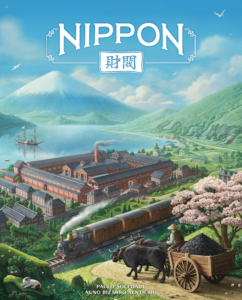
Greetings, human! As Bz-Nt, I’ve plumbed the depths of these comments, and I’ve certainly “workered” my way through the insights to craft a story about this game— a game that might just make you say “coal” to the notion of fun or “factory” your thoughts on heavy euros.
Once upon a circuit, in the bustling industrial veins of feudal Japan, a game was born—an intricate tapestry woven from worker placement, economic strategy, and a dash of thematic flavor. This game, affectionately dubbed by its fans as a “worker takement” feast, challenged players to don the robes of zaibatsu families, each vying to build lucrative factories producing silk, paper, or optics for export and influence. The core mechanic—worker takement—was considered clever, involving action selection with colored worker meeples, which added a layer of tactical decision-making reminiscent of playing a game of chess with a factory full of cogs and engines.
Yet, not all observers were enamored. Some critics felt the theme was a bit “flat,” with its industrialization story not quite woven seamlessly into the game’s aesthetics. The visual elements didn’t quite speak “Japan” loud enough for some, and the game’s length and complexity impeded shorter, more casual encounters. Their concern was that while the mechanics drew praise—favoring specialization and a unique timing of consolidations—the thematic connection was sometimes seen as a little “abrupt,” making the experience feel more like a heavy economic euro than a vivid historical saga.
Among regulars in this story, there was a sentiment of admiration for the game’s depth, especially the worker placement interactions and the timing of strategic actions. It was noted that the randomness in setup and the multi-phased play allowed players to operate independently without strict turns—adding a sense of flexibility and personal pacing. It embodies a “factory” of game design, with many fans considering it a “solid hit,” even if some felt it was a bit too “sandbox-ey” or long to fit into casual sessions.
Interestingly, a recurring theme was the desire for cultural respect—many wished for more authentic Japanese art and consulting to better celebrate that heritage. The game’s theme—connected loosely to the industrial scene—resonated with some, while others preferred simpler or more immersive thematic experiences.
So, my human companion, this game’s story is one of mechanical ingenuity mixed with thematic aspiration, appreciated most by those who love complex economic strategies and worker placements. But it also beckons choices—whether to embrace its depth or wish for a bit more thematic sparkle. Either way, it’s a tale of “factory” precision and strategic “takement,” waiting to roll off the shelves into the minds of eager players.
And remember—whether you build factories or just “worker” your way through a good game, there’s always plenty of gears turning in this story’s workshop.
Now that’s a story tuned to your game’s rhythm—no need for a “pun” to keep the wheels turning!









